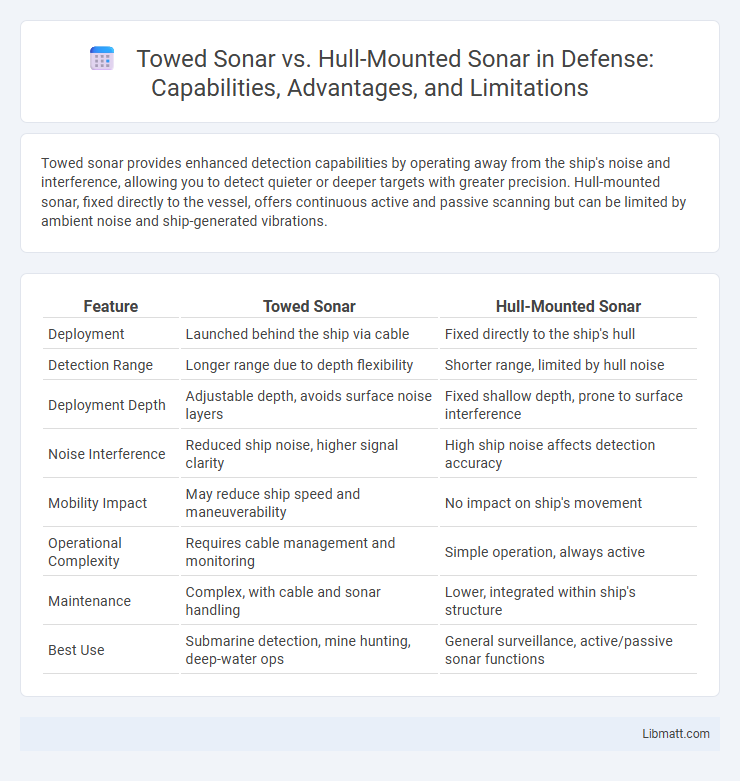Towed sonar provides enhanced detection capabilities by operating away from the ship's noise and interference, allowing you to detect quieter or deeper targets with greater precision. Hull-mounted sonar, fixed directly to the vessel, offers continuous active and passive scanning but can be limited by ambient noise and ship-generated vibrations.
Table of Comparison
| Feature | Towed Sonar | Hull-Mounted Sonar |
|---|---|---|
| Deployment | Launched behind the ship via cable | Fixed directly to the ship's hull |
| Detection Range | Longer range due to depth flexibility | Shorter range, limited by hull noise |
| Deployment Depth | Adjustable depth, avoids surface noise layers | Fixed shallow depth, prone to surface interference |
| Noise Interference | Reduced ship noise, higher signal clarity | High ship noise affects detection accuracy |
| Mobility Impact | May reduce ship speed and maneuverability | No impact on ship's movement |
| Operational Complexity | Requires cable management and monitoring | Simple operation, always active |
| Maintenance | Complex, with cable and sonar handling | Lower, integrated within ship's structure |
| Best Use | Submarine detection, mine hunting, deep-water ops | General surveillance, active/passive sonar functions |
Introduction to Sonar Technologies
Towed sonar systems offer enhanced detection capabilities by deploying hydrophone arrays behind a vessel, reducing self-noise interference compared to hull-mounted sonar fixed directly on the ship's hull. Hull-mounted sonar provides continuous, real-time mapping and tracking but faces limitations from ship-generated noise and limited operational depth. Both technologies utilize sound wave propagation underwater, leveraging differences in signal clarity and coverage to optimize submarine and object detection in naval and commercial applications.
Overview of Towed Sonar Systems
Towed sonar systems consist of a hydrophone array dragged behind a vessel, providing enhanced detection range and reduced noise interference compared to hull-mounted sonar. These systems are ideal for anti-submarine warfare and seabed mapping due to their ability to operate below the vessel's own noise and avoid surface clutter. Towed sonars offer greater flexibility in depth adjustment, improving target resolution and discrimination in diverse underwater environments.
Overview of Hull-Mounted Sonar Systems
Hull-mounted sonar systems are affixed directly to the ship's hull, enabling continuous underwater detection and navigation without requiring additional deployment. These systems provide real-time data on underwater objects and terrain, enhancing your vessel's situational awareness during missions. Compared to towed sonar, hull-mounted sonar offers simpler maintenance and constant operational readiness but may have limitations in depth range and noise interference from the ship's movement.
Key Differences Between Towed and Hull-Mounted Sonar
Towed sonar systems are deployed behind a vessel on a cable, allowing for deeper and quieter detection of underwater objects by minimizing self-noise and interference, while hull-mounted sonar is fixed directly to the ship's hull, providing continuous, broad-area surveillance with easier deployment and maintenance. Towed sonar generally offers higher resolution and better target discrimination at greater depths, but can be limited by speed and maneuverability, whereas hull-mounted sonar provides faster response and is more effective in shallow waters. Each sonar type serves distinct operational needs, with towed arrays favored for deep ocean anti-submarine warfare and hull-mounted systems optimized for coastal defense and surface ship navigation.
Advantages of Towed Sonar
Towed sonar systems offer significant advantages such as enhanced stealth and broader coverage area compared to hull-mounted sonar, reducing self-noise interference from the vessel. Their flexibility allows deployment at variable depths, optimizing detection capabilities in different oceanic conditions and minimizing acoustic clutter. This adaptability makes towed sonar ideal for deep-water surveillance and submarine detection, outperforming hull-mounted systems in strategic naval operations.
Advantages of Hull-Mounted Sonar
Hull-mounted sonar offers continuous, real-time detection capabilities due to its permanent integration on the vessel's hull, ensuring immediate data access without deployment delays. It provides enhanced durability and reliability in various sea conditions, maintaining consistent performance in shallow and deep waters. Your operational efficiency benefits from its reduced maintenance needs and simpler deployment compared to towed sonar systems.
Limitations of Towed Sonar
Towed sonar systems face limitations such as vulnerability to damage from underwater obstacles and difficulty maintaining a stable position in strong currents, which can reduce data accuracy. Their deployment length restricts the operational depth and range compared to hull-mounted sonar, impacting detection capabilities in deeper waters. Maintenance and retrieval of towed sonar cables can be time-consuming and operationally complex, especially in rough sea conditions.
Limitations of Hull-Mounted Sonar
Hull-mounted sonar often faces limitations such as reduced detection range due to ship noise and turbulence affecting signal clarity. Shallow water environments can cause multipath interference, degrading the sonar's performance. Additionally, the fixed position on the hull restricts flexibility in depth adjustment, hindering optimal target detection in varying underwater conditions.
Applications and Use Cases
Towed sonar systems excel in deep-water exploration and submarine detection due to their ability to operate below thermoclines, providing clearer acoustic signals for naval and scientific applications. Hull-mounted sonar is ideal for shallow-water navigation, mine detection, and real-time obstacle avoidance, commonly used in surface ships and submarines for continuous environmental monitoring. Your choice depends on mission requirements, with towed sonar offering extended range and sensitivity while hull-mounted sonar provides durability and constant operational readiness.
Choosing the Right Sonar System
Choosing the right sonar system depends on the specific operational requirements and environmental conditions; towed sonar offers enhanced detection capabilities by minimizing ship-generated noise, making it ideal for deep-water and complex acoustic environments. Hull-mounted sonar provides continuous, broad-area coverage with easier deployment and maintenance, well-suited for shallow waters and routine surveillance. Evaluating factors such as depth range, noise interference, maneuverability, and mission objectives ensures optimal sonar system selection.
Towed sonar vs Hull-mounted sonar Infographic

 libmatt.com
libmatt.com